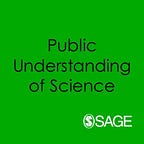Uncertainty. How It Makes Science Advance
Review by Sharon Dunwoody
This book offers a good starting point for scholars who seek an introduction to the concept, and it should find its way onto reading lists in courses from communication to the sciences.
In my work with science communication students, both those with professional writing goals and those in training to become scholars, I have always urged them to think of science not just as an uncertainty-reducing process but also as an uncertainty-generating one. All well and good. But this slim text has convinced me that, in doing so, I achieved only half of my educational responsibility. Accepting the ubiquity of uncertainty in science is a start, but learning how to not let uncertainty get in the way of understanding is the critical next step. This book emphasises that latter goal in a way that can inform both students and their instructors.
The two authors are well equipped to handle this challenge. Kampourakis, educated in biology and with a Ph.D. in science education, explores the public understanding of evolution, genetics and the nature of science at the University of Geneva. McCain is a philosopher of science at the University of Alabama at Birmingham who focuses on epistemology. Both care deeply about teaching, a passion that undergirds the organisation and clarity of this book.
Science seeks to understand the why and how of phenomena, the two authors note. The book makes a rigorous effort to define what it terms “genuine” scientific understanding and to contrast that effortful, evidence-based end-point with the kind of common-sense, perceived understanding that we embrace in our day-to-day lives. Studies of what audiences glean from media coverage of science show that much of what we encounter in popular venues is indeed informative but too limited to permit the kind of deep understanding identified by Kampourakis and McCain. Further, we think we understand more about a phenomenon than we actually do. Worse, that relatively superficial “hit” on a topic or issue may lead us to distort the role of uncertainty in what is likely to be true.
The authors devote the first part of their text to an explanation of uncertainty and to why uncertainty is inherent in science. They categorise uncertainty as either epistemic, stemming from the quality of evidence, or psychological, the very human process of making a likelihood judgement. They suggest that uncertainty’s ubiquity in science derives from the incredible complexity of our world — rendering any causal effort incomplete — and from the fact that scientists, as do all humans, bring with them psychological limitations that affect both perception and interpretation. Scientists seek to minimise those limitations — the scientific process was created to accomplish just that — but they cannot eliminate them.
This leads our authors to focus on “the roots and the possible impact of uncertainty in science”, and they handle that beautifully through a series of case studies. A case study permits vividness and specificity at the cost of external validity. But it is an important narrative device, and the authors employ it here to identify major uncertainties underlying what we think we understand about an array of issues that appear frequently in societal discussion today: climate science, the health impacts of vaccination, evolution, genetic testing and forensic science.
Popular messages about science — whether via mass media, museums, blogs — rarely address these major uncertainties openly; they typically languish below the surface of stories and, thus, are routinely missed by audiences. Science communication scholars, while giving greatly increased attention to uncertainty in content and audience perceptions since I and colleagues published Communicating Uncertainty: Media Coverage of New and Controversial Science in 1999, still define the concept rather superficially (as did we in our book!).
The careful explication offered in this modest text will be of service to our scholarly community, as will the authors’ effort, in the last third of the book, to make the case that the presence of uncertainty in science should lead us to accommodate it in such a way that we can still believe what science knows and not label it inferior to other ways of knowing.
I do wish the authors had focused more on the politicisation of uncertainty and its use as a rhetorical tool in ideological battles. That point does get aired in some of the case studies, as well as in the book’s last chapter. But so much of what non-scientists say about uncertainty is saturated in efforts to persuade via misleading or downright deceptive messaging. I think this element deserves a chapter of its own.
All told, though, I found this to be an excellent and readable treatment of uncertainty. It offers a good starting point for scholars who seek an introduction to the concept, and it should find its way onto reading lists in courses from communication to the sciences.
Sharon Dunwoody is Evjue-Bascom professor emerita of journalism and mass communication at the University of Wisconsin-Madison, where she taught and studied science journalism processes for more than 30 years. A recent, relevant publication is (with Kohl, P.A. et al): ‘The influence of weight-of-evidence strategies on audience perceptions of (un)certainty when media cover contested science’, Public Understanding of Science 25(8): 976–991.
